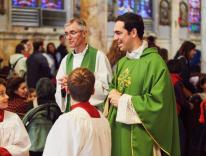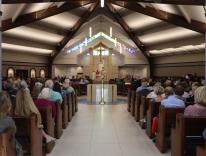On a spring day in 1944, two seminarians chatted about ordination to the diaconate with its commitment to celibacy, scheduled for the following morning in the seminary chapel. I remarked, “For heaven’s sake, John, if you can take the step, I certainly can.” John’s response was unnerving: “Well, Harry, I have news for you. I won’t be here tomorrow. I’m out of here.” I was the one who stayed, however much I questioned the rule of celibacy. I felt called to priestly ministry and trusted, perhaps naively, in the assurances of church authorities that celibacy enhanced one’s spiritual life and ministry.
Now at age eighty-three, after fifty-nine years of a happy and exciting priesthood, my early questioning of celibacy has been confirmed. Rather than an enhancement, celibacy has been more of a distraction. Unmarried, the priest ideally can give more of himself and his time to ministry, but it does not always work out that way. Compensations easily insinuate themselves-golf, tennis, bridge, social activities, hobbies-and make disproportionate demands on the time and energy said to derive from celibacy. Without a high-octane spiritual life, other less acceptable activities can come into play: drinking, race tracks, casinos. As a form of asceticism, celibacy’s heroic demands are more at home with a hermit in the desert or a monk in a monastery than with a priest ministering in today’s highly charged sexual atmosphere.
Celibacy has an enormous value to the person and to the church when it is a continuing mandate of the heart-the most total giving of oneself to the Lord. As an extreme form of asceticism, it would be expected to be accompanied by other ascetical practices and a deep, even mystical spirituality. But is it? Celibacy may be mandated, but the personal and social context so necessary for it to thrive and be supported cannot be legislated. John Paul II proclaims an eschatological purpose for celibacy when lived “for the kingdom”: The celibate is an icon illuminating the condition that awaits all the faithful. Living as an icon is a big reach for flesh-and-blood human beings-certainly for me. But the pope goes further when he claims that the priest is ontologically different from the rest of humankind. This, too, goes beyond my experience and my understanding of the ontological scale as consisting essentially of mineral, plant, animal, human, angelical, and divine. I fail to see priest as another distinct category. For those sailing in these mystical waters, these considerations may well be compelling. But I have always regarded my priesthood as trying to become an alter Christus in service to others-the faithful and a wider circle of humanity-in ministering the sacraments, proclaiming the gospel vision of Jesus, and re-presenting his redeeming sacrifice with the assembly, all the while being a creature of body and spirit.
As for my own experience of celibacy, efforts, however faltering, at maintaining a prayer life and a level of devotional and intellectual spirituality have made for a happy priestly life: twenty-four years in chancery administration, another twenty-six years as pastor in two New York City parishes, and eight years retired as weekend associate in a lively parish. The gospel simplicity of the words and example of Jesus, the overarching Catholic intellectual vision and its rich cultural traditions, learning from people, and the camaraderie of fellow men and women gave a coherence and sense of well-being in day-to-day ministry. But celibacy has not been an easy road. Physical awareness was literally aroused in the all-male seminary on visiting days, when the click of the high heels of classmates’ sisters was heard on the cloister walk. Such arousal would not diminish with ordination. While not delighted with the prospect of a celibate life, I viewed it as part of the packaged priestly ministry that I felt called to-a ministry to serve others that would also be personally fulfilling. Now I wonder if it must be so packaged.
The world of ministry was too busy to allow preoccupation with the demands of celibacy. Chancery work involved evening meetings in civic affairs and frequent dinner sessions with friends and colleagues. Regular duties at my parish of residence occupied a couple of evenings a week. Playing the role of priest, the Roman collar, professional reserve, and a context of parish and friends all proved effective safeguards against anything more transgressing than occasional lack of custody of the eyes.
Vacations were something else again. Here are a few brief snapshots. A Maine resort with a priest classmate: In mufti, we mixed with young men and women of our own age on the beach, after golf, and on an evening schooner cruise, adroitly handling questions about schools, occupations, and home neighborhoods. About the fifth day, my friend who had made an interesting acquaintance said, “Harry, let’s get out of here. This is getting too hot to handle.” We left. Subsequently he had many years as a teacher, then left for marriage. I had seen an evolution in a friend’s attitude toward celibacy.
In 1950, a priest for five years, a ski vacation in Vermont: I became an impromptu bartender in the small lodge. Along with several couples, there were a group of five unattached girls and this unattached clergyman. Conversation flourished, especially with one, a lovely blond, a devout Catholic, and a person of considerable intelligence. Our friendship flourished over a couple of ski seasons and the possibilities were obvious. But I was in one context of life and she in another. I was happy in mine. She married. We still exchange Christmas cards.
A flight to Bermuda: A priest colleague and I found ourselves at JFK Airport. We two young priests in vacation garb were the only persons at the gate. The airplane was being sent down empty to bring back a crowd of returning weekenders. It was a delightful trip. The eight flight attendants on board were as amused as we were at the unusual situation and gave us the same splendid attention that we gave them. We invited them to our hotel but unfortunately they had to fly right back. You never knew what might have been!
Rome, Siena, Venice: An elderly friend-a widow-and her daughter had taken a villa in Siena and invited me to join them in Rome and then move on to Siena. At Rome, I dined alone one evening at the Scolio De Frisio restaurant. Two college girls at a nearby table, spotting a fellow American with a Roman collar, smiled, came over to chat, and invited me to their table. They were very pleasant and after dinner we drove around Rome by night in their rented Fiat. Both were Catholic and easy conversationalists. I invited them to my Mass the next morning at Santa Maria Maggiore with my widow friend and her daughter. After Mass, we all had breakfast together and met several times in the next few days, while I enjoyed their commentary on Italian men. Good-byes and I was off to Siena, where in the Villa Santa Bonda, my widow friend proved a gracious host, entertaining some of the local literati. On the feast day of St. Catherine of Siena, I was visiting the house, thronged with tourists, where Catherine had been born. I was pleasantly surprised to encounter my two friends from the Scolio De Frisio. They fitted in easily at Villa Santa Bonda. They were on their way to Venice and would I like to join them? Venice was made more exciting by their pleasant company. I had enjoyed Rome, Siena, and Venice, however briefly, with these charming women of grace and intelligence. It suggested once again the possibility of a different kind of life. But life is a series of choices and I was content with mine. My only regret about the trip is that I do not remember their names-those lovely girls. What might have been is not to be known.
Continuing in the 1950s: I had recently received a woman into our Roman communion. She was the American wife of the Catholic laird of the tiny Isle of Canna in the Inner Hebrides off the western coast of Scotland. They were delighted to have me for Mass in their little church as the parish priest visited only every three months. The household also included two young married couples and a striking blond young lady, a university student from Germany. Canna had an interesting cast of characters.
hese vacation encounters and others made me more aware that a woman is another world, another experience, another frontier, a possible partner in understanding, work, and faith. I thought of my friend, Clark Oler, an Episcopalian pastor, who often told me how important his wife was to his life and his work; also of my friends, Rabbi Irving Block and his wife Phyllis, an inseparable part of his life and his ministry. When I spoke at his funeral a year ago, his congregation chuckled as I said, “Rabbi Block and Phyllis were the best argument I ever saw for a married clergy.” I did not regret the choice that I had made, while acknowledging that my church might have worked things out a little differently, giving its priests the freedom accorded by other religious traditions to their clergy.
What kind of mental change was I undergoing regarding celibacy? Hitherto, in adolescence, prayers were constant for chastity and purity. We were warned against the evil of impure thoughts and of impure actions with self or others in a manner that reflected the principle we found later in seminary textbooks: “there is no parvity [smallness] of matter in sins involving sex!” If you steal a dime-parvity of matter-it’s a venial sin; if $10,000, a mortal sin. But regarding sex, no parvity of matter whatever. Willfully lingering over Playboy had the same ominous fiery clouds that hung over adulterous carryings-on. Confessors allowed twelve-year-old boys to continue to be terrified at the normal workings of male hormones, telling them to take cold showers and read spiritual books, so that these sudden eruptions might eventually cease. The ecclesiastical failure to distinguish between deliberate “self-abuse” and something that just more or less happens is indicated in an otherwise beautiful Anglo-Saxon evening prayer: “May we awaken in the morning without stain.” As one matures, sexuality is perceived as a normal part of human existence, without ominous red lights constantly flashing, however much there may be the need for yellow lights of caution. Has our church for too long put a frequently distorted sexual morality at center stage? Has it made young people too introspective and self-centered regarding sex rather than presenting it in more relational terms? Can this self-centered quality linger on into adulthood? Is it facilitated by mandated celibacy?
n those early years of priesthood, the negative images of sexuality gave way to a more balanced view. My casual encounters with the bright eagerness and vitality of the flight attendants, the glimpses of idealism in my dining companions at the Scolio De Frisio, the searching intelligence of the German university student, a long-term intellectual and faith-filled friendship with the elderly widow, and the rock-solid faith of my Vermont skier taught me that relationships between men and women are, indeed, rewarding.
As one grows older, disaffection can develop toward a mandated social climate that, to some degree, excludes a relaxed relationship with half the human race-women. Our easy relation through prayer and devotion to Our Blessed Lady says something about our ability and tendency to relate effectively to the feminine. Has the core freedom of the Christian person to marry and to experience a fully human life been diminished by a kind of institutional by-law? How is this to be justified? Interestingly, Pope John Paul II has frequently proclaimed marriage as an essential right of the human person. For what purpose then, this mandated priestly celibacy? Initially, it stemmed from an ascetical impulse derived from early monasticism; then in the Middle Ages for protection of church property. Many bishops, priests, and theologians in the eleventh century engaged in widespread debates for and against mandated priestly celibacy, sought by the papacy to prevent the inheritance of church property by the sons of priests. A Bishop Ulric of Imola urged Pope Nicholas II (1058-61) not to ban priests from marriage because it is a natural right and such a ban might drive some of them to homosexual acts. History has verified this possibility: witness men in prison or on shipboard, deprived of the company of women, frequently resorting to homosexual practices. And, we might add, some clerics without a deeply spiritual and prayerful life, who turn, as we so well know today, to the most available and vulnerable-children and young people. Property considerations at that earlier time prevailed, and the ban became part of the church’s human apparatus. Church property is now protected by more sophisticated measures, leaving control of the presbyterate as the chief motive covered by an unconvincing veneer of asceticism.
As the ambit of Christian freedom is increasingly felt today, and with Vatican II’s more positive attitude toward marriage, there has been an abandonment of ministry by thousands of priests, mostly for marriage. Recently, substantial numbers of priests of the dioceses of Milwaukee, New Ulm, and Albany have petitioned the U.S. bishops to undertake a study of optional celibacy. Many bishops at the 1998 Synods for Asia and for Oceania and at other synods have requested permission to ordain married men. The synod secretariat carefully screened out these requests from the propositions submitted to the pope. The recent report of the U.S. bishops’ National Review Board, while disclaiming a causal relationship between celibacy and sexual-abuse, nevertheless called for a study of other considerations, such as immoral relationships with adult men and women on the part of some priests, the extent of which is not known. Yet in the face of all this, together with the priest and vocation shortages, a disproportionate homosexual presence in our clergy, and the possible relation of celibacy to the scandal and other aberrations, John Paul II continues to ban any discussion or study of mandated clerical celibacy.
In the 1960s and 1970s, it would not be surprising that many of the clergy who stayed would have had to make considered decisions to remain in ministry. I seriously considered a particular prospect of marriage, but stayed, because of an underlying commitment to ministry as packaged in man-made policies of our church and to the network of family, friends-Catholic and non-Catholic-and colleagues. At the present time, with the collapse of social norms and the old supportive networks, younger men considering priesthood and those in their early years of ministry may not find sufficient reason or support to undertake or continue the steep commitment celibacy entails. Furthermore, to make celibacy a strict condition for priestly ministry subjects the individual to a form of institutional control that is nearly total. To have power over a person’s sex life is to have remarkable control of that person. It not only touches his private life but shapes his social and public life as well, and, in today’s church, that includes one’s employment, compensation, and residence.
But how effective can such control be? Recent history proves instructive. The clergy sexual-abuse crisis, which has left our church reeling, happened under such conditions. Thousands of children damaged; enormous amounts of church funds expended; the public reputation of the priesthood seriously wounded. The harm done by a minuscule group of miscreant priests was exponentially multiplied when bishops knowingly transferred offenders to other assignments, making the hierarchy actively complicit in the damage. Yet we know of no bishop being removed for failure in this regard. A few resigned when their own sexual abuse of minors became public. Even Cardinal Bernard F. Law of Boston, on whose watch the scandal exploded, having resigned after his people and priests rose up, still sits prominently on several Vatican congregations and was recently appointed archpriest of Santa Maria Maggiore in Rome. The February report of the U.S. bishops’ National Review Board called the bishops’ mismanagement and lack of accountability “shameful to the church.” It concluded that “We see this crisis as one of the episcopacy as much as it is a crisis of the priesthood.”
It is not surprising, then, that many priests and those who might consider priesthood have little or no confidence in the authority figures who have so clearly failed in the sexual-abuse scandal. To my mind, however content I am with my own life choices, this only adds to the current vocation crisis.
Now in the end zone, retired for eight years, I find being weekend associate at a Hudson River parish enormously fulfilling. It is a joy to preside at liturgies, to preach, and to make contact with people as faith and sacraments intersect with their lives. But the need for intimacy and sociability rather than the earlier pressures of sexuality are now more keenly experienced. Couples much more readily than single persons arrange and are invited to dinner parties and other social affairs. My married brothers travel on vacations with their wives. For the retired priest loneliness is accentuated. The bright vision of faith, the spirituality and the sacraments that come from the Jesus of the Gospels, lasting friendships, and the memories of thousands of adventures of being with people while trying to be, however imperfectly, an alter Christus provide a welcome sunset glow after fifty-nine years as a priest of New York. But as for celibacy, an ancient Anglo-Saxon prayer might well be addressed to our pope and the bishops as well as to the Lord: “Supply the secret needs of our hearts that no dark cloud of evil passion may overshadow those whom the light of thy heavenly grace has strengthened.” Amen!
Please email comments to [email protected] and join the conversation on our Facebook page.
Share
Previous Story
Want to stay married?
Next Story
A PRIEST FOREVER?


